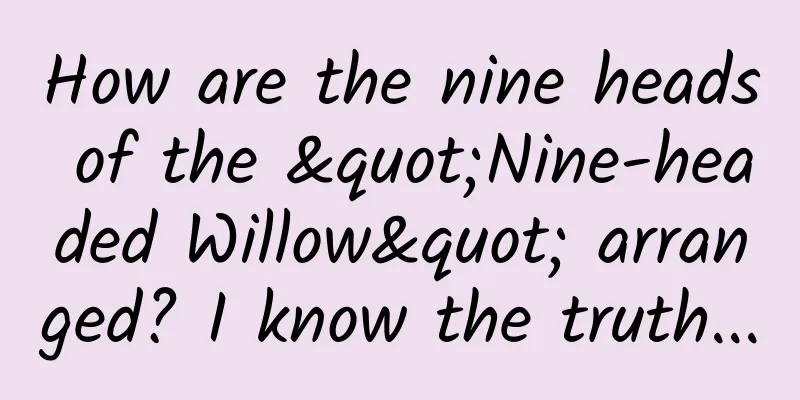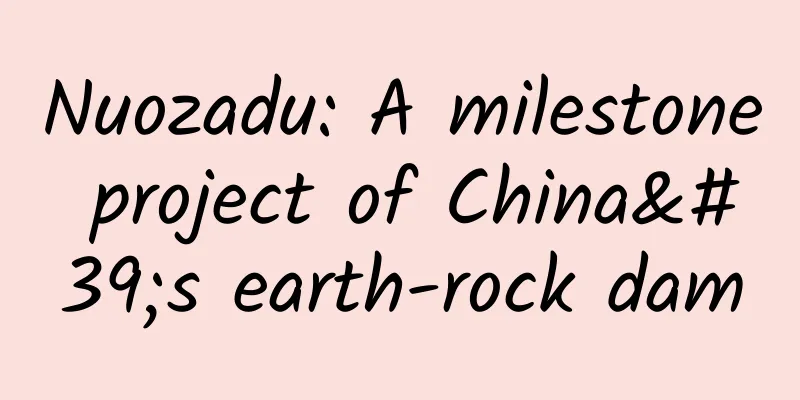How are the nine heads of the "Nine-headed Willow" arranged? I know the truth...

|
Is anyone watching the recent hit drama "Longing"? In this drama, there is a very funny plot, which is Xiaoyao's soul-searching question to "Hydra Xiangliu" - How do your nine heads grow? Image source: Screenshot from the TV series I have to say that Xiaoyao is simply a substitute for many people. Who wouldn’t be curious about this question? Although the TV series did not provide an answer, this problem does have a solution. Not only does it have a solution, but it is also a visual solution. How are Xiangliu's 9 heads arranged? The answer is in the Classic of Mountains and Seas The original novel of "Chang Xiangsi" is based on "Classic of Mountains and Seas". Xiangliu's appearance and the arrangement order of his 9 heads can also be found in "Classic of Mountains and Seas". The most widely circulated version now comes from the "Expanded Annotations to the Classic of Mountains and Seas" by the Qing Dynasty scholar Wu Renchen. Without further ado, here are the pictures: Wu Renchen (Qing Dynasty). Extensive Notes on Shanhaijing However, this cannot actually be considered Xiangliu’s “official ID photo”. To understand why I say this, we have to start with the book "Classic of Mountains and Seas". What kind of book is "Classic of Mountains and Seas"? Many scholars have discussed this issue. One view is that "Classic of Mountains and Seas" is actually a collection of "picture descriptions" . Its original body was probably an (imaginary) map or a collection of imaginary creatures (similar to the Bai Ze Tu and Bao Pu Zi Deng She). The Shan Hai Jing that we see today is probably just the textual description of these maps and pictures . Fragment of the Tang Dunhuang Bai Ze Tu In fact, there are many signs that the "Classic of Mountains and Seas" had pictures in the Middle Ages . Guo Pu, a famous scholar in the Western Jin Dynasty and the earliest annotator of the Classic of Mountains and Seas, wrote the “Pictures of the Classic of Mountains and Seas”. The great poet Tao Yuanming also mentioned the “Flowing View of Mountains and Seas” in his poems. Zhang Sengyou, a famous painter of the Southern Dynasty of Xiaoliang, also painted the “Pictures of the Classic of Mountains and Seas”. In these pictures, the strange appearance of Xiangliu with a nine-headed snake body will definitely be highlighted. Unfortunately, none of the above drawings have survived to this day . Fortunately, although these pictures of Shan Hai Jing from the Middle Ages have not been preserved, we can still see pictures of Shan Hai Jing drawn by artists in modern times . At present, the earliest works of this kind are those of the Ming Dynasty, with two versions, Hu Wenhuan and Jiang Yinghao. The other is the aforementioned Qing Dynasty scholar Wu Renchen's annotations to the Classic of Mountains and Seas, which also published some illustrations at the same time. Complete Works of Ancient and Modern Books (Qing Dynasty) compiled by Chen Menglei / revised by Jiang Tingxi (Qing Dynasty) During the Edo period in Japan, a scroll of "Strange Birds and Beasts" was published, which also included some "strange birds and beasts" patterns from the Shan Hai Jing. "Strange Birds and Beasts" Another Japanese version of Xiangliu's image, from Tang Tu Xun Meng Tu Hui (1802) Who is Xiangliu? Why does he have 9 heads? Xiangliu's appearance is very strange. The "strange" here does not refer to his "nine heads" but his "snake body". In ancient Chinese mythology, the image of "human head and snake (dragon) body" often represents the god of creation. The most typical ones are Fuxi and Nuwa. Pangu is also likely to have a dragon (human) head and snake body. In addition, Lei Shen and Gong Gong are also like this. Tang Dynasty: Picture of Fuxi and Nuwa When we talk about Xiangliu now, we all say that he is a subordinate of Gonggong, but if he is just a subordinate of Gonggong, his status does not seem to be very high. How can he be listed alongside all the ancient gods? The contradiction in this may indicate that Xiangliu's identity is not ordinary . There are two passages about Xiangliu in the Classic of Mountains and Seas, and the content is almost exactly the same: Xiangliu has nine heads. Each head eats food from one mountain, and the nine heads together eat food from nine mountains. Wherever it passes, it will become a swamp - it doesn't look like a snake, it's a super typhoon. The presence of this thing will definitely destroy the flood control plan. So Dayu tried to kill Xiangliu. But I didn't expect that the blood gushing out from Xiangliu's body was fishy and smelly, and no plants could grow where it flowed. Moreover, a lot of water came out where the typhoon disappeared, no, where Xiangliu was killed. At first, Dayu wanted to fill up the water with soil. He tried three times, but the water collapsed again. Dayu had no choice but to make do with what he had and use the water to dig a large lake around the lake. The soil dug out of the lake was piled up next to it to build a high platform. Why does Xiangliu have nine heads? This question is not much discussed in the field of mythology. But let's open our minds: The two mythological characters, Dayu and Gonggong, are closely related to the earth beneath our feet. Dayu "dredged the mountains and rivers and made tributes from the soil" to distinguish the nine states, and was the creator of the administrative divisions on earth . The nine states themselves are another name for the earth. As for Gonggong, although he is considered the god of water, in fact, there is often not much difference between water and soil. More importantly, the "god of the earth" in mythology, Julong, is the "Earth God", the "Earth God" in "Emperor Heaven and Earth", and is the son of Gonggong. What about Xiangliu, who was related to both Dayu and Gonggong? He had nine heads and went to nine mountains to eat. Wherever he went, he would bring a lot of water. This water fell to the front, back, left, and right of each mountain, forming huge lakes and swamps, which could surround the mountain. The mountain became a huge island - the "zhou" in "Yu Bie Jiuzhou" actually meant land in the water. According to this understanding, Xiangliu's nine heads may have some relationship with the Jiuzhou. 1 Bigger Brain Hole The Qin and Han Dynasty book "Spring and Autumn Annals" says that the Human Emperor, one of the Three Sovereigns, has nine heads (the Human Emperor has nine heads). Readers familiar with fantasy online novels know that King Zhou in "The Investiture of the Gods" is the "Human Emperor", so King Zhou should also have nine heads . Considering that the attribute of "Nine Heads" is not common in the world of gods and ghosts, we can roughly draw the following conclusions by rounding off: King Zhou was Xiangliu. Finally, please accept the love from 9 heads: Author: Xu Lai, a popular science writer Review | Wang Hongzhi, Associate Professor, School of Humanities, Shanghai Normal University |
Recommend
Two boys were playing on the ice and fell into -10℃ cold water! How to save yourself if you fall into the water on the ice?
Around 4 p.m. on January 11 In a park in Shijiazh...
Does it really help to lie down with your eyes closed when you can't sleep?
Addendum 1: Although lying down with your eyes cl...
Changhong CHiQ TV 40Q1N review: A new way to play with young smart 4K
As emerging enterprises are rising and home applia...
The National Day routine is here, I won’t tell ordinary people about it!
The annual National Day holiday is coming! Are yo...
Break all the unreliable rumors! What can a dishwasher bring to our lives?
Nowadays, if you want to live a high-quality life...
Korean flagship showdown: LG G3 vs. Samsung S5
The official release of LG G3 has attracted a lot ...
How to deal with space junk? Does it need to be sorted?
Before we knew it, the Shenzhou 14 crew has been ...
Product Operation: How to build a product structure pyramid?
If you do marketing for a long time, you will hav...
The best way to get the width and height of View in Android
In Android, there are usually multiple ways to ge...
Baidu announces testing of self-driving taxi Apollo Go in Beijing, available on Baidu Maps App
With the gradual maturity of 5G networks and hard...
Beware! 4 people were poisoned! Just because they drank this soup...
Recently, the Panyu District Market Supervision B...
Figure out these 8 questions and save 50% of your advertising and marketing budget!
The content discussed in this article is applicab...
What is the meaning of "耀" in the Book of Songs? People in the Pre-Qin Dynasty: Firefly, you have successfully attracted my attention!
"In the dark forest, a silver light suddenly...
Can science explain the legend of “turning hair white overnight”?
Many people have seen the scene of "turning ...









